Return
to Main Page
The Bread of the Holy Mountain
Observations from Mount Athos
|
|
Note: Having spent nearly two weeks on the Holy Mountain, I
am the first to admit that I did not spend nearly enough time there to
compile the information necessary to present anything approaching a
comprehensive treatment of the bread of Mount Athos. I am also limited by
the absence of good photography, since many of the monasteries I visited
do not permit photography inside the walls of the monastery itself.
I must also mention that I observed a great deal of
practical variances between monasteries. What was done as one
monastery was not necessarily so at another, each having its own communal
life organized according the needs of each community. So, what is
presented here is not a summary of the 'Athonite Tradition' per se, since
it does not necessarily exist in all matters. Rather, there are
numerous traditions depending on where you are. For example,
monasteries ate different types of bread: whole wheat, durumThe importance
appeared to be consistency in doing what you were taught and not minding
one's neighbors or changing things on a whim.
Any further observations are welcome, and those which are
helpful will be posted with the kind permission of the sender. Please email me
your observations, and please be as
specific as possible as to where you obtained your
information.
To help clarify some of the text, I have
reproduced several pictures from monastic communities (I don't know
exactly where these photos were taken) which I hope will help make some of
the text a little clearer. After you have read through the text
below, come back to these photos and study them a little more
carefully. You will see a number of details which may not have been
noticed before.
Of course, I would appreciate any photos you may have and are willing
to share with the public.
|
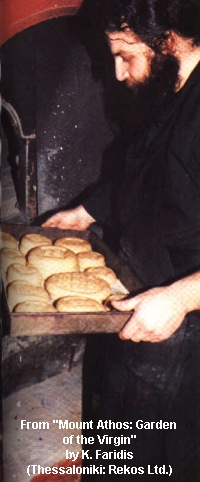
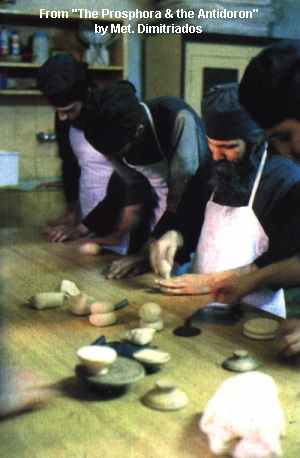
|
|
|
|
|
The Journey to Konstamonitou
|
Our first stop was at the Holy Monastery of Konstamonitou (5
April 2002), where the hard-working monks showed us a great deal of
hospitality despite there own austere lifestyle. On the second day
of our visit, an English-speaking monk agreed to give me a tour of the
monastery bakery. It consisted of a simple two-room area, with a
large battery-operated machine mixer in one and a huge wood-fired oven in
the other. There is little electricity on the Mountain, and this
monastery relies on solar-panels to power the few lightbulbs they have,
one of which peered into the dark cavern of which would make an West Los
Angeles gourmet pizza chef tremble in awe. It spanned some five
yards, a fine Roman brick dome. Ashes are dragged to the front right
side of the oven floor, where they slide down a chute to a waiting bucket
during the cleaning process.
|
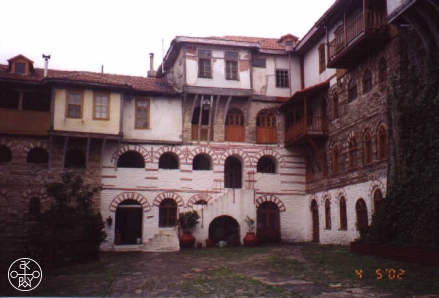
|
This oven supplied all the baking needs of the monastery, both
prosphora and daily rations. In the basement, a later tour revealed the
original monstery oven, well over three times its size but unused in the last
100 years or so because of the decrease in the number of monks. Since the
monstery has reversed the trend under Abbot Agathon, the monks will eventually
begin using it as their numbers grow. In case you were wondering, these
ovens operate thusly: a fire in built in the middle of the oven floor, which is
allowed to burn down to coals. Since these are indoor ovens, they are not
vented through the top. Instead, smoke pours out through the front door
and rises into metal hoods, which not only collect the soot but also administer
bruises to the uncautious (like myself). Once the fire has died down, the
coals are swept to the sides and the hot floor is prepared for the loaves, which
are slid into place with large wooden shovels or 'peals' (an artistic rendering
is seen on the main page of this website). The bottoms are dusted with
coursely-ground grains, which keep the loaves from sticking.
As you can imagine, such bread lends itself to different
shapes. The regular loaves of daily bread were very long, baking in metal
trays to keep them from sticking together. Lots of small loaves would be
difficult to put in and take out of the oven, so they opt for length. The
loaves were two-hands wide and came out about as tall.
The monastery stocked two kinds of flour: yellow durum flour and
white flour, the former used for the regular bread and the latter for
prosphora. The durum, a very hard wheat, rendered a tasty but extremely
dense loaf. I doubt it would succeed commercially, but these struggling
monks find it best for their needs. A slice of this and a bowl of beans
will keep you filled for the day. The sourdough flavor comes from starter
which is continually maintained from one batch to the next.
The prosphora is a different matter. Made with white flour,
they are about the size of a man's fist. The baker insists that the dough
is not leavened with a starter, but from being left out and allowed to collect
naturally-occuring yeast in the air of the church, which is then brought in and
allowed to rise and bake. The bread is tangy in taste and very dense,
owing to the wild yeast. It appears to be a time-consuming process, since
the small batches do not warrant use of the enormous power mixer used for daily
bread.
There was some debate between the baker and the
translating monk as to the proper way to shape a loaf. The
small loaves are in two parts, the top being slightly smaller than the bottom. The translator
explained that at Philotheou Monastery, where many of the older monks
had their start befor being reassigned to Konstamonitou to reenvigorate its dwindling community,
the bread was shaped into a single ball, then held
between the outside edges of the hands and rolled back and forth until two parts
were shaped (without separation), something like a compact bowling pin. The stamp would
then be pressed into the top and the loaves would be baked.
This makes prosphora shaped like gently lopsided hour glasses rather than there being a
stark line or seam between top and bottom portions. While I visited Philotheou
later, there was not a Liturgy scheduled for that day
and so I did not observe the loaves there.
The baker demonstrated his technique in pantomime, since there was
no dough available (kind of air guitar for bread experts). He rolls the
dough out into a sausage shape, then selects a spot 2/3 the way down the length
of the roll. Using the outside edge of his hand, he presses down and rolls
the loaf back and forth, carefully creating an even 'neck' in the dough but not
separating the two portions. This is critical enough to merit him
mentioning it several times. Once the neck was sufficiently thin, he draws
up the two portions into individual balls, tips them over in the larger end and
mashes them together with the seal. No water necessary to glue the parts
together. It is worth noting that the loaves were far from symmetrical,
but retained a beauty nonetheless.
The surprise of that morning were the bread
stamps themselves. The first appeared to be a common enough Russian style
stamp, consisting of a 1 1/2" Lamb with minimal decoration. The second
I had never seen outside George Galavaris' "Bread and the Liturgy" (Madison,
WI:Univ. of Wisconsen Press 1970, Figure 60, Page 106) Below I have reproduced
the image Galavaris used in his book, taken from the Deutsches
Brotmuseum in Ulm, Germany. Below it, I have negativized it and reversed the
image so you can get an idea of the impression it leaves on
the dough. It is worth saying that the abbreviated characters and the reversed order
(right-left) of on this stamp were not characteristics of the Konstamonitou stamp.
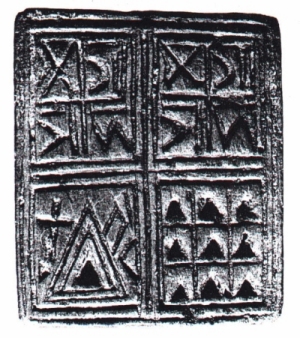
|
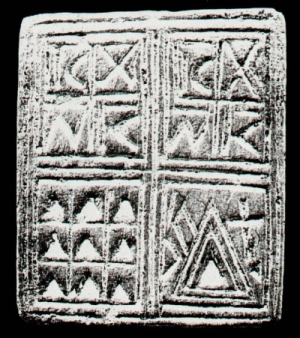
|
|
The original
stamp
|
Reversed and
negativized
|
The translator went on to explain that the first loaf was used for the Lamb,
while the second was used for the commemorations. Unlike America, only the two loaves
used for the Liturgy are cut up for antidoron. More monks
meant smaller pieces, not more loaves. At Xenophontos, it appeared that more loaves were used for the Sunday
Liturgy of our visit, probably due to the great number of both monks and
pilgrims.
Sts. Dionysios and Mitrophanis House,
Little St. Anna's Skete
|
It was to my great surprise, several days later, to sit down
to lunch at the Holy Skete only to have a prosphora set before each
plate! Before, I had only seen the cut up remains of prosphora or a
few being held in reserve for the next Liturgy. Here I had my chance
to actually pocket one of these beauties, and made my plans to slip it
into my cassock. By this time on the trip, I had begun to notice
that while each monstery or skete had its own style of daily bread and
meal format, the prosphora remained relatively the same in
shape.
You can imagine my great sorrow when the monk across from
me, noticing my great admiration for his handiwork, proceeded to break it
for me so that i could 'enjoy' it with my meal. I was
haeartbroken! The flavor was tangy as any good sourdough, and had
the dense consistency of a dry dough with natural leavening. Our
guide explained to Abbot Spyridon my interest in bread, and so after the
meal he provided me the two loaves seen below. The monks explained
they had an unusually large batch of bread which wouldn't make it without
molding, so the abbot blessed them to be eaten with meals. Actually,
one prosphora, as dense as it is, is a meal unto itself.
This house had numerous examples of ancient prosphora stamps
found on the mountain, which I was unable photograph. If God wills
that I return, I will try to photograph the skete's stamp
collection. My brief conversation at the skete revealed that they
also bake in the same way Konstamonitou does.
|

|
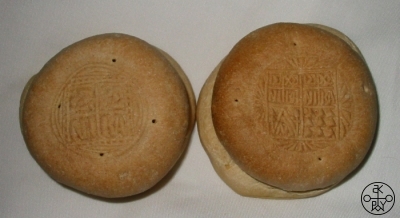
|
|
|
Here are the two loaves from Sts. Dionysios and
Mitrophanis house of Little St. Anna's Skete. Notice the piercings
and the configuration of the particles on the right loaf. These are
typical of Athos prosphora.
|
|

|
|
|
An up-close view of commemorative
loaf.
|
|
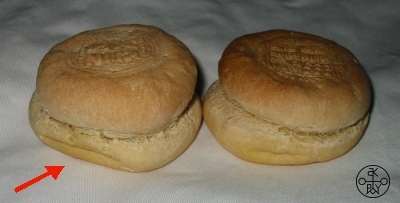
|
|
|
A 2/3 view of the loaves for perspective.
Notice the dictinct joint between segments, yet the entire loaf is made
from a single piece. The red arrow indicates a dent left by the
baker's peal and the loaf was placed in the oven after being allowed to
rise. The right side loaf has a smaller dent in the same
location. Also note the evenness of the upper portion as compared to
the unevenness of the bottom portion, caused by the weight differential
from the stamping process.
|
|
|
|
|
The Great Lavra
|
Our guide at the Great Lavra knew a great deal about the bakery,
and was able to share some interesting facts about the monastery and its
bread. First, the monastery never refuses to give bread to anyone
who asks, since they have had numerous miracles since the time of St.
Athanasios the Athonite where the Theotokos Herself stepped in to avert
famine for the community. The Lavra until recently ground its own
flour, using a donkey-driven millstone. The funny part is that the
monks decided to buy flour only after the donkey died, since they couldn't
train a replacement!
During the Feast of the Elevation, the abbot blesses a bowl with water
and flour in the katholikon, using a fragment of the True Cross. The
bowl is then left out overnight. This becomes the starter for the
coming year's prosphora. The monk recalled one year when a baker
decided not to use the new starter and tried to bake a batch with the old
one. It didn't work, and the monk had to go to the abbot and confess
what he had done, since he had bowls full of dead dough. The abbot
came and blessed the dough, and almost immediately it began to rise.
It will be a long time before anyone else gets up the nerve to mess with
this annual tradition.
|

|









